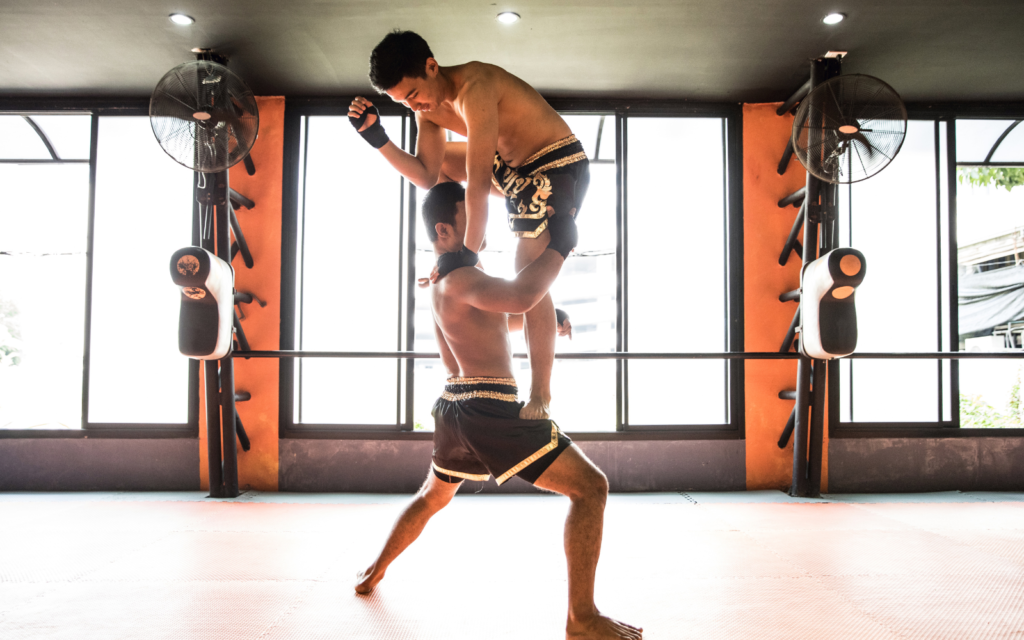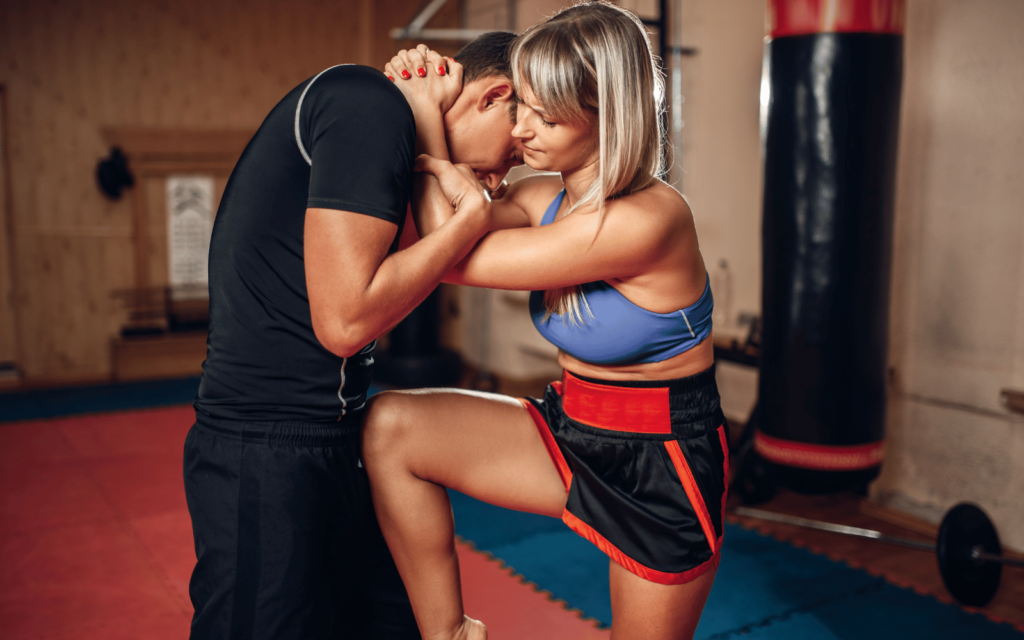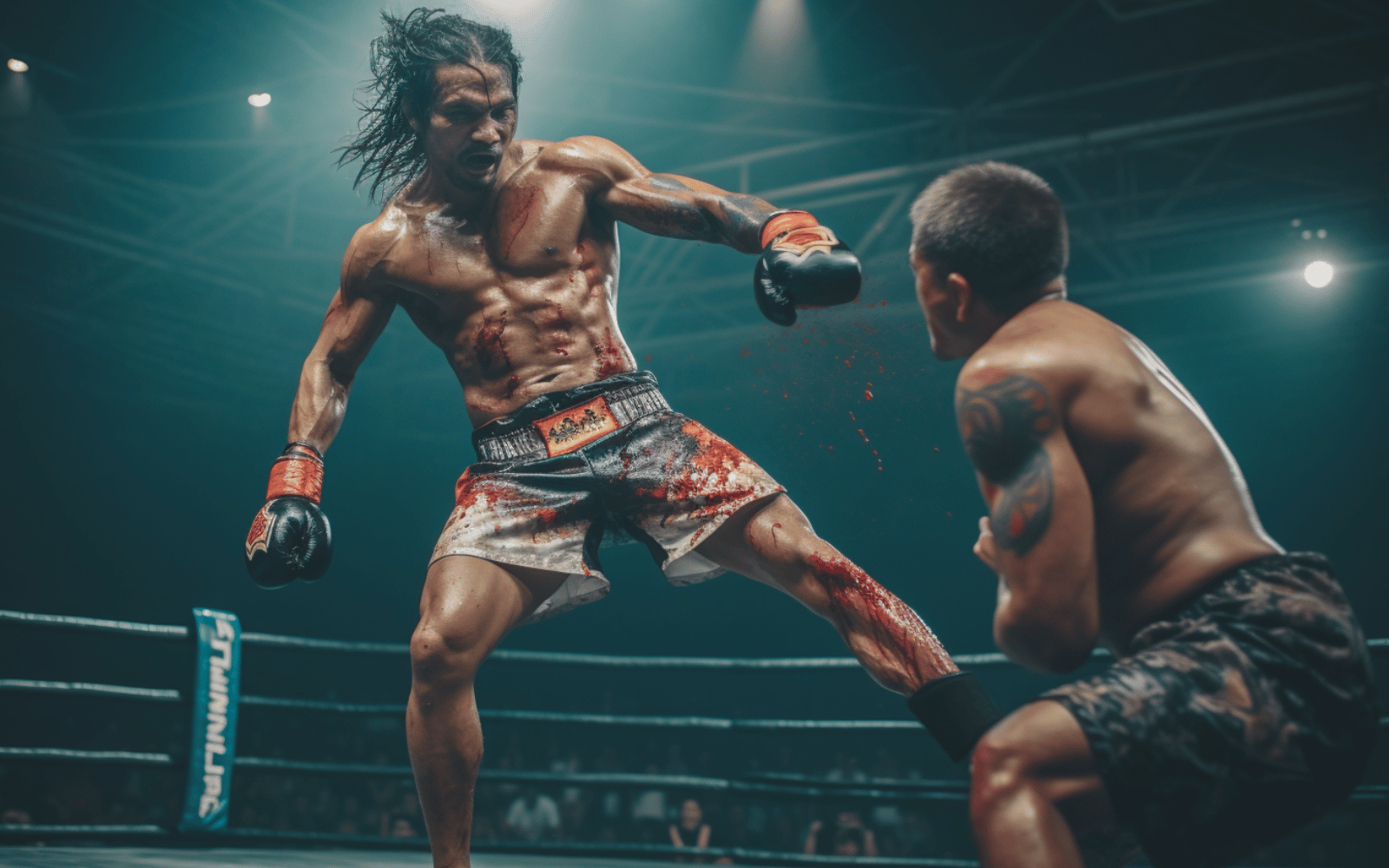Lethwei vs Muay Thai, two ancient martial arts hailing from neighboring countries in Southeast Asia.
Both sports are steeped in culture and tradition and revered for their raw intensity and technique.
And while they share several similarities, each offers its unique flavor of striking artistry.
So in this article, we’ll explore their origins, techniques, and the nuances that set each full-contact combat sport apart.
Lethwei vs Muay Thai: Main Differences?
There are some pretty notable differences between Muay Thai’s fighting style and Lethwei.

Here’s a quick breakdown of the differences in techniques and rulesets:
Techniques
Lethwei and Muay Thai are both striking martial arts, but they have distinct differences in striking techniques.
Muay Thai is often called the art of 8 limbs, but in Lethwei, fighters can use a ninth weapon – headbutt attacks. This is a unique feature compared to other martial arts and is used as a devastating weapon.
As a result, to make headbutts more effective, Lethwei fighters tend to have a more upright posture and stance, which is relatively squared, providing better balance for punches and kicks.
Another major difference is that they don’t wear gloves, only hand wraps.
On the other hand, Muay Thai prohibits headbutts, and in its modern form, fighters wear boxing gloves.
Muay Thai fighter stance and posture tend to lean forward slightly to help generate power in kicks and better protect the body. It’s more side-on than square, focusing on strong rear kicks and using the body, especially the shin, and elbows, as shields against attacks.
Lethwei vs Muay Thai: Rulesets
And traditional rules of Lethwei matches don’t use a point system, so a win is typically achieved by knockout; otherwise, it’s a draw.
This means there’s often continuous fighting without many breaks. So, when you think about it, Lethwei is like a real-life Blood Sport.
Muay Thai matches are decided based on a 10-point system, and victories can be achieved through points, knockouts, or the referee’s discretion.
Lethwei vs Muay Thai: Main Similarities?
Lethwei and Muay Thai, while distinct in their own rights, share numerous similarities that can be traced back to their Southeast Asian roots. Both martial arts employ a wide range of devastating strikes.
Clinch fighting, a close-range combat style where fighters aim to control their opponent’s posture, is a pivotal aspect in both.
As are the use of powerful elbow strikes and knee strikes.

When it comes to training, both Lethwei and Muay Thai practitioners often engage in similar methods, such as pad work, sparring, and clinch drills.
Plus, both require their martial artist to possess exceptional fitness, agility, power, and endurance.
And even pre-fight rituals are quite similar and play an integral role in both sports.
Muay Thai showcases the “Wai Kru,” and Lethwei maintains its traditional practices.
And also, within professional competition, the modern rule of both sports allows for a 2-minute rest period between rounds.
History of Lethwei
Lethwei, often referred to as “Burmese bare-knuckle boxing” or simply “Burmese boxing,” is a traditional martial art originating from Myanmar (Burma).

Its roots trace back to an ancient form of combat practiced over a thousand years ago. Historically, Lethwei bouts were fought in sand pits instead of rings, emphasizing the sport’s raw nature.
Due to its location, the evolution of Lethwei was influenced by the martial art forms of neighboring countries like Muay Boran (the ancient form of Thai boxing) from Thailand and Muay Lao of Laos.
Leading up to its modern form, Lethwei saw significant changes in the 20th century.
One of the most influential Burmese fighters in this modern evolution was Kyar Ba Nyein.
In the 1950s, Kyar Ba Nyein, an accomplished Burmese boxer, introduced refinements to Lethwei techniques, helped formalize its rules, and promoted it as a sport throughout Myanmar.
His efforts not only revived interest in Lethwei but also set the foundation for its contemporary practice, taking it from sand pits to formalized rings and making it a bit more accessible to a global audience.
History of Muay Thai
Muay Thai has its roots deeply embedded in the cultural fabric of Thailand. Originating in the 16th Century, it was developed as a form of brutal combat used by Thai warriors on the battlefield.
But as the years progressed, it transitioned from the battlefield to become a spectator sport, with fighters testing their skills in front of an audience.
Starting in the 20th Century, Muay Thai began to undergo significant transformations. It began to incorporate techniques from Western traditional boxing and adopted the use of boxing gloves.
Along with these changes came more modern rulesets, making fights safer and more standardized for competitors.
The sport started hosting formal competitions in stadiums in Bangkok and paving the way for it to become a globally recognized martial art and sport.
Muay Thai vs Lethwei — Who Would Win in a Street Fight?
Lethwei and Muay Thai offer powerful striking techniques suitable for street fighting scenarios.
Lethwei’s allowance for headbutts gives practitioners an extra weapon, potentially giving them an edge in unexpected close combat situations.
However, Muay Thai’s extensive training of elbows and knees and signature powerful leg kicks offer its own set of advantages.

So What’s Better for Self-Defense?
They’re both a brutal form of martial art that can certainly help you defend yourself.
However, when you consider the addition of headbutts, especially in a street fight where you may end up on the ground, it’s tough to choose against Lethwei.
Let’s say you end up on the ground with the arms and legs in use rolling around. Your head is potentially the only weapon available to you to escape.
It’s brutal to consider and very dangerous, especially if you miss and hit your head on the ground. But it’s conceivable that it’s your only option.
Lethwei vs Muay Thai: Which is Easier to Train?
In terms of availability to train, it’s obvious that Muay Thai is a more popular form of martial art globally.
In not only Asian countries but also Western ones, you can easily find a Muay Thai training facility due to its widespread appeal.
While Lethwei, though gaining traction, is less widespread in terms of training centers outside of Myanmar.
Then regarding the actual training, it’s much more likely you’ll be able to handle Muay Thai Training over Lethwei. Because it’s so popular, many Muay Thai gyms in the West are like ‘kick fit’ programs to get you in shape.
And while they don’t necessarily train headbutts in sparring, etc., the simple act of headbutting even a heavy bag could have unforeseen side effects down the road.
And so, given the broader availability and recognition of Muay Thai, it might be easier for most individuals to find opportunities to train in Muay Thai.
Famous Lethwei Fighters
Here are some notable figures in Lethwei.
Dave Leduc
Leduc is a Canadian Lethwei fighter known for his significant contributions to popularizing Lethwei on the international stage. And has won multiple Lethwei World Championships and is recognized for his dominant performances in the ring.
Beyond his fighting prowess, Leduc has played a pivotal role in introducing and promoting Lethwei to a broader audience outside Myanmar, such as his appearance on the Joe Rogan podcast.
Too Too
Too Too is a prominent figure in the world of Lethwei. He’s a Burmese fighter known for his aggressive style, exceptional skills, and numerous victories, he has made a significant mark in the sport.
His matches are often characterized by his relentless pace and his ability to absorb and deliver punishing blows.
He fought Dave Leduc in a brutal and exhausting title fight that went the full distance.
Over the years, Too Too has become a celebrated figure in the Lethwei community, representing the sport’s traditional spirit while also showcasing its evolution in the modern era.
And as a result, he’s solidified his position as one of the legends of Lethwei.
Famous Muay Thai Fighters
There’s a relative ton to name but here are just a few notable mentions.
Rodtang Jitmuangnon
Rodtang is a Muay Thai fighter with an aggressive, fearless fight style that’s become a crowd favorite.
He’s often likened to a “tank” because of his forward-moving pressure and ability to absorb blows while delivering powerful strikes. This tenacity has earned him the nickname “The Iron Man of Muay Thai.”
Rodtang has faced many top-tier fighters throughout his career and achieved significant domestic and international success. Competing at the highest levels, he has secured numerous titles, including his reign as a ONE Championship Muay Thai titleholder.
His ferocity in the ring, combined with his humble and likable personality outside of it, has solidified Rodtang’s position as one of the modern-day greats in Muay Thai.
Saenchai
Saenchai PKSaenchaimuaythaigym, commonly known simply as Saenchai, is one of the most celebrated and talented fighters in modern Muay Thai.
His evasive style, characterized by creative and often playful movements, sets him apart from many of his contemporaries.
He possesses the rare ability to make world-class opponents look ordinary, often fighting and winning against larger and heavier adversaries.
Throughout his illustrious career, Saenchai has won numerous titles and has competed in different weight classes. He is a multiple-time Lumpinee Stadium champion, certainly one of the highest accolades in Muay Thai.
And if you follow him on Instagram, you’ll see Saenchai traveling the world, facing international opponents and conducting seminars, spreading his knowledge and love for the sport.
Including teaching in my hometown!
His charisma, combined with his undeniable talent, has made Saenchai a legend in Muay Thai and a global ambassador for the sport.
Buakaw Banchamek
Buakaw has become a symbol of Muay Thai excellence in his homeland of Thailand and on the global stage.
He is famous for his powerful strikes, exceptional speed, and unwavering discipline in the ring.
His prowess gained significant international recognition when he became the first fighter to win the K-1 World Max tournament twice – in both 2004 and 2006.
A brave warrior, he’s no stranger to defeating top-ranked opponents from different striking disciplines. And this has earned him respect and admiration beyond the Muay Thai community.
Stamp Fairtex
Stamp Fairtex, or Natthawan Panthong, is a prodigious talent in both Muay Thai and Mixed Martial Arts (MMA).
In Muay Thai, Stamp’s combination of power, precision, and technique has made her a formidable opponent. And she’s won both the ONE Atomweight Muay Thai and Kickboxing World Championships -making her ONE’s first ever 2 sport world champion.
Beyond her in-ring achievements, Stamp Fairtex has become a source of inspiration for many female Muay Thai fighters. She represents the potential of transitioning skills across different combat disciplines and the spirit of a true martial artist.
Lethwei vs Muay Thai in Closing
In the world of striking martial arts, Lethwei and Muay Thai are legendary, representing the rich histories and cultures of Myanmar and Thailand.
While their roots are intertwined with shared techniques and traditions, each sport has its distinct identity.
Understanding the subtle and not-so-subtle differences between them offers a deeper appreciation of the martial spirit embedded in Southeast Asia and the global impact these arts have made.
Whether you’re drawn to the raw, no-glove intensity of Lethwei or the rhythmic “Art of Eight Limbs” that is Muay Thai, both promise a journey of discipline, power, and confidence.
